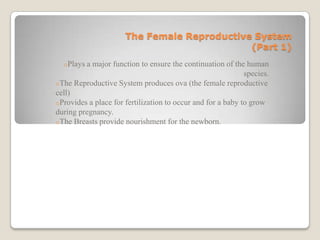
The female reproductive system10
- 1. The Female Reproductive System (Part 1) oPlays a major function to ensure the continuation of the human species. oThe Reproductive System produces ova (the female reproductive cell) oProvides a place for fertilization to occur and for a baby to grow during pregnancy. oThe Breasts provide nourishment for the newborn.
- 3. The Female Reproductive System consists of both internal and external genitals, the reproductive organs. Internal Genitalia are located in the pelvic cavity and consists of the uterus, two ovaries, two fallopian tubes, and the vagina.
- 4. A hollow pear-shaped organ that contains a thick muscular wall, a mucus membrane lining and a rich supply of blood. It lies to the center of the pelvic cavity between the bladder and the rectum. It is normally bent slightly forward (anteflexion) The uterus has three sections: the fundus (upper portion between where the fallopian tubes connect to the uterus. Corpus (the body) central portion and cervix or lower portion (the neck of the uterus), which opens into the vagina. The inner layer (endometrium) of the uterine wall contains a rich blood supply. It reacts to hormonal changes every month that prepares it to receive a fertilized ovum. It provides a place of nourishment and protection for the developing baby. If there is no fertilization, the endometrium is sloughed off, resulting in menstruation (shedding of the lining of the uterus)
- 5. Two Ovaries Small almond shaped glands that produce ova (ovum) and the female sex hormones. One located on each side of the uterus. Hormones from the anterior pituitary, follicle stimulating hormone and luteinizing hormones stimulate maturation of ovum and trigger ovulation ( the process by which one ovary releases an ovum The female sex hormones produced by the ovaries estrogen and progesterone stimulate the lining of the uterus to be prepared to receive a fertilized ovum.
- 6. Uterine tubes or oviducts. 5 ½ inches long and run from the area around each ovary to either side of the upper portion of the uterus. The unattached ends of these tubes expand into fingerlike projections called frimbriae. The frimbriae catches an ovum after ovulation and directs it into the fallopian tube. The tube then propels the ovum from the ovary to the uterus so it can implant.
- 7. The Vagina Muscular tube lines with mucous membrane that extends from the cervix of the uterus to the outside of the body. Allows the passage of the menstrual flow. During intercourse, it receives the male penis and semen (fluid containing sperm) Serves as birth canal through which the body passes during a normal vaginal birth.
- 8. What purposes does the vagina have in the female reproductive system? Where does fertilization take place? How many arteries are in the female reproductive system? What reproductive part protects a developing child? Review
- 9. The End